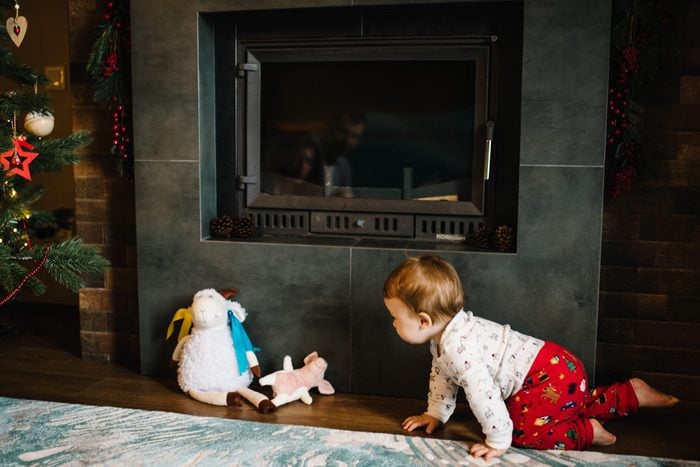How To Babyproof a Fireplace
Updated: Dec. 13, 2023

Protect young children from fireplaces and flames with these smart and easy tips, straight from a professional babyproofer.
According to KidsHealth.org, more than-one third of accidental injuries to children happen at home. Babyproofing or childproofing helps guard against burns, which account for some of the most traumatic and permanent home injuries. Stitches or staples from a child face-planting on a brick hearth are no picnic, either.
Peter Kerin, owner of Foresight Childproofing, is an advanced certified professional childproofer through the International Association for Child Safety with 20 years experience helping parents keep their kids safe. He’s also a father of three who stayed home with his kids.
“The dangers involving a fireplace are potentially very challenging, life-altering events,” Kerin says. “The good news is that they are reasonably preventable, and it doesn’t have to be expensive.”
Babyproofing Gas and Woodburning Fireplaces
In babyproofing a fireplace, Kerin says similar safeguards apply whether you’re burning gas or wood. Here are some basic steps to take regardless of heat source, make or model.
Limit fireplace use
Kerin suggests using the fireplace sparingly with children nearby. Glass stays hot long after you’ve extinguished the fire, so here’s a test: When the kids aren’t around, light a fire, then monitor how long it takes to cool down. That will help you gauge how much time needs to pass before allowing kids near the fireplace.
Babyproof the hearth
Nearly all fireplaces have a hearth. That’s where kids trip and fall. Here’s how to babyproof a hearth; best to use both suggestions in tandem.
- Add padding. Putting a cushion around the edge of the hearth can prevent bumps, bruises and stitches. For raised hearths, Kerin says the Cardinal Gates brand “offers an easy peel-and-stick option to cover the edges that’s wonderful and stays on. They also offer an option that clamps on the edges.”
- Maintain space around the fireplace. “Configuring gates, like this one from KidCo, denies access to both the hearth and the fire,” Kerin says. Those accordion or mesh gates/screens in front of a fireplace aren’t for child safety; they’re keep embers from blowing out and landing on the floor. They get really hot and most are freestanding, making them anything but babyproof.
Babyproofing Electric Fireplaces
Kerin says electric fireplaces offer fewer dangers for children. “Most of the electric fireplace is visual,” he says. “The heater is inside and fan-driven, so they typically don’t pose as much of a threat.” However, keep these safety measures in mind.
- Check the temp (roughly). When the kids aren’t around, let the fireplace heat up. Check the wall or glass carefully so you know exactly how hot it gets. “Verify how hot it is, and your child’s access to the fireplace itself,” Kerin says. Also, see how long it takes for the wall or glass to cool off. It’s likely longer than you think.
- Maintain some space. Kerin considers the European Union’s safety standards “meaningful” and follows those when he can. For electric fireplaces, keep kids 30 inches away from the heat source. For fireplaces with open fire, increase the distance to 35-1/2-inches — about three feet.
- Deny access to plugs, switches and remotes. Electric fireplaces often have electrical cords with plugs, remote controls and various switches and dials to control heat and flame. Evaluate your model and determine what works best. For some electric fireplaces, it might mean unplugging the unit after use and adding a plastic socket cover. For others, rocker switch covers keep kids safe and prevent guests from accidentally switching on what they think is a light, or brushing up against a switch and unknowingly turning on the fireplace.
Final Thoughts on Babyproofing a Fireplace
“It’s the safest time to be a child in the history of this country,” Kerin says. “Those stats bear out. We have a better understanding of our children and their development. We have information about how they get injured. We also have better products.
“Newer gas fireplaces are much safer than older ones. Things are going in the right direction, but that’s because we have knowledge, and we’re using that knowledge.”
